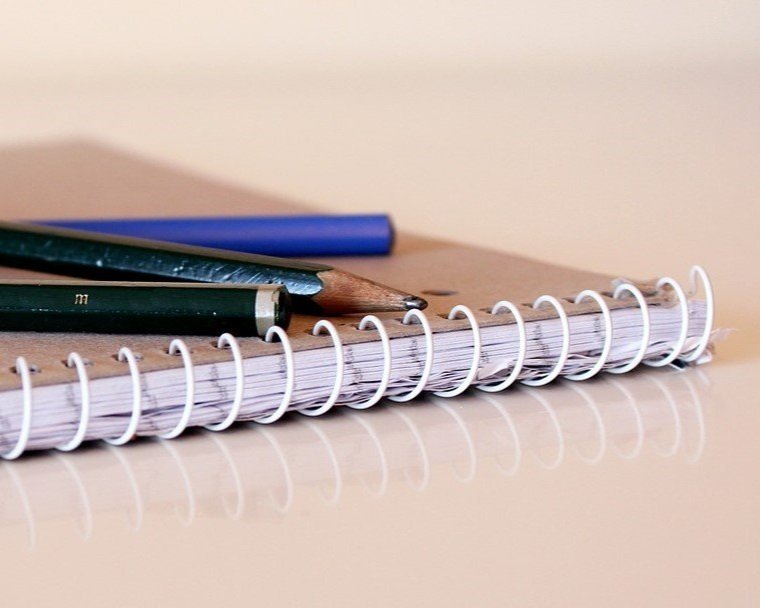
In the previous two posts on this topic, I covered the importance of taking good notes, whether it is during a college lecture, a business workshop, or a church sermon. Quite simply, note-taking is a great way to stay focused on the information that is presented, and it results in a concise set of information that can easily be referred to later.
During Part I, located HERE, I went over some of the reasons WHY it is important to teach these skills to students. Then I touched on what is a good age to start and where you can find opportunities to practice. In Part II, HERE, I covered how to listen for signal words so you will be clued in on WHAT to write.
Well, in this post we will be going over how to organize your notes as you write them. After all, if your notes are a jumbled, unorganized mess, they won’t be very helpful to read later on, will they?
You see, when you approach a lecture session, you need to take notes so you don’t have to go back to rewrite or decipher them. They need to be written in a logical organized way. One way to do this is to create a flow chart. Flow charts are especially good for topics that are small in scope. You place the main idea at the top of the page and use arrows to point from it to the major subtopics. Then you can use more arrows from the major subtopics to the smaller points, using examples with them. Like this:

You will find that flow charts will probably not work for most lecture intensive situations, however. In these cases you will most likely use an outline form, writing the main topic on the left of the page with maybe a little general information about it. It will be given the Roman numeral I. Then as major points are introduced, they are given capital letters (A,B,C, etc.), followed by examples for those points which are designated with Arabic numerals (1,2,3, etc.). Then if there are any sub-points, they are listed with lower case letters (a,b,c, etc.). Finally any supporting information for those sub-points will be designated with lower case Roman numerals (i, ii, iii, iv, etc.). It will look something like this:

Use the margin of your paper to highlight major points with bullets or asterisks. When you hear a new idea introduced, add a new number and write that main idea. Then reverse indent the rest of the text as you write the information that goes with the new topic. Reverse indenting helps to visually separate your information on the paper.
When you write your notes, you should not be writing in complete sentences. I know. Most students are trained to never do this. But you simply cannot write as quickly as a person speaks. So learning how to abbreviate words and shorten sentences will help. Additionally, in the next lesson, I will give you some helps with special “note-hand” techniques to speed up your writing.
The only time you should be writing word-for-word is if you are given a vocabulary definition. Make sure you underline the vocabulary word so it is easy to spot within your notes.
Also, with each new major point, skip a line. This adds a visual break within your notes so you can more easily see the flow of the information.
As I mentioned in the last post, in order to help you identify when a new point is being introduced, listen for signal words. Because time is often limited during a workshop or class, whenever a lecturer pauses to write something on the board, make sure you write that down as well. Copy down any diagrams or sketches, too. Often it is easier to explain a concept this way.

Sometimes a lecturer will pause for a minute or two. This most likely means that the information he just talked about was so important that he is giving you time to write it down. Make sure you do!
If you miss a point, leave a space in your notes to fill it in later. Don’t try to look at your neighbor’s notes during the lecture because you may miss more. Ask someone after the lecture if you can fill in what you missed.
Do your best to write as neatly as possible, because this will make your notes easier to use later.
Finally, if you hear a technical term that you are unsure how to spell, write it down phonetically (just sound it out). You can look up the proper spelling or ask someone later. Circle the unknown word so you will remember to come back to it.
Now, why isn’t all this information written in a “Step 1,” “Step 2” format? Well, speakers have various lecture styles. Some write information on a board while others tell lots of stories in between giving out specific details. Some are flamboyant while others are, well, less-than-flamboyant. It takes time to figure out how to “read” the speaker’s cues. Add to that fact that students each have their own note-taking techniques that will best fit their learning and writing style and be intuitive for them when referring back to their notes.
No one way is right or wrong. But with intentional preparation and practice, you will be able to figure out the best way to write legible and organized notes so they can later be uniquely used by you for later study.
Taking good notes offers many benefits to students, including helping them maintain concentration in class and actively involving them in a lecture. It also helps them to better take in information using several senses as they are listening, writing, and looking at their notes.
In the next post, I will cover special tricks and helps to write more quickly, using abbreviations and shortened note-hand techniques! Click HEREfor Part IV!

